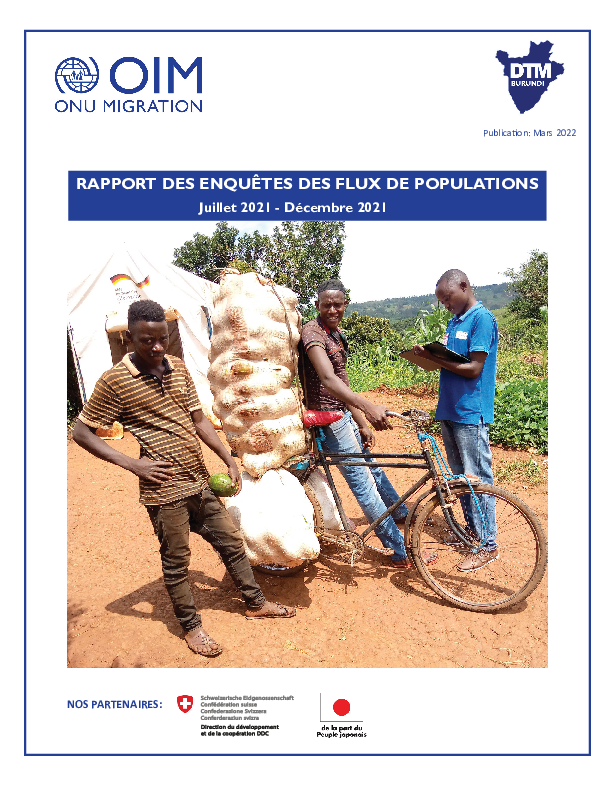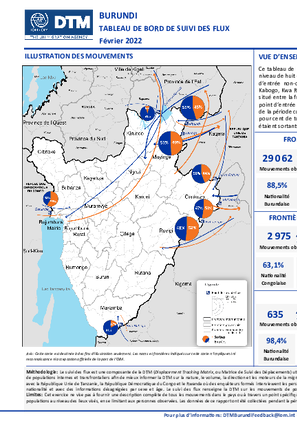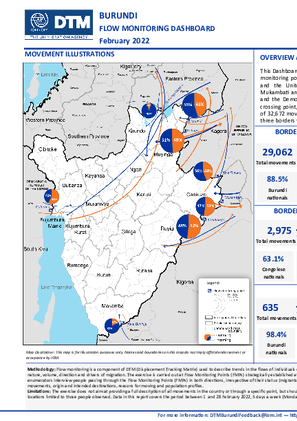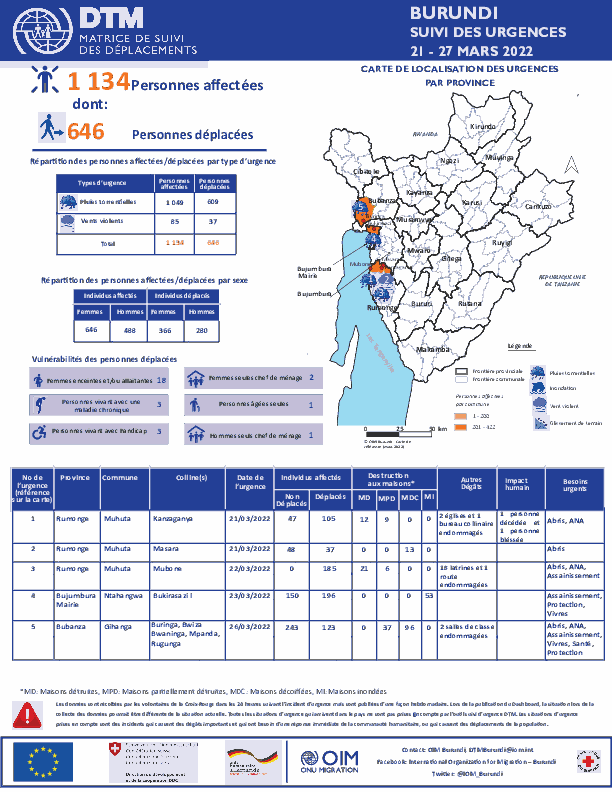-
Countries
-
Data and Analysis
-
Special Focus
-
Crisis Responses

Contact
DTM Support — iomdrcdtm@iom.int
Language
French
Location
Democratic Republic of the Congo
Period Covered
Mar 27 2022
Mar 29 2022
Activity
- Event Tracking
- Mobility Tracking
L’évaluation rapide de l’OIM (Emergency Tracking Tool, ETT) est un outil mis en place dans le but de collecter des informations sur les mouvements importants et soudains de populations. Ces informations sont collectées à la suite de visites sur le terrain et/ou d’entretiens téléphoniques avec les informateurs clés des sites de déplacement ou des communautés d’accueil. D’autres informations sont ensuite recueillies et analysées à partir des outils d’évaluation rapide multisectorielle (ERM). Ce rapport synthétique présente les résultats de l’évaluation menée par entretiens téléphoniques du 27 au 29 mars 2022 avec des informateurs clés.

Contact
DTM Burundi, DTMBurundi@iom.int
Language
French
Location
Burundi
Period Covered
Jul 01 2021
Dec 30 2021
Activity
- Flow Monitoring
Ce rapport présente une analyse des enquêtes de suivi des flux (Flow Monitoring Survey, FMS) réalisées entre juillet 2021 et décembre 2021. Au cours de cette période, 5 868 entretiens ont été menés auprès des voyageurs ayant traversé cinq (5) points de suivi des flux (Flow Monitoring Points, FMPs): Kabogo, Mbundi, Kwa Rutuku, Mukamba et Kabuyenge installés à l’est du Burundi à la frontère avec la République Unie de Tanzanie. Ces enquêtes font parle des activités de suivi des flux mises en oeuvre par l‘OIM par le biais de la matrice de suivi des déplacements (Displacement Tracking Matrix, DTM).

Contact
DTM Burundi, DTMBurundi@iom.int
Language
French
Location
Burundi
Period Covered
Mar 14 2022
Mar 20 2022
Activity
- Event Tracking
- Mobility Tracking
Entre le 14 et le 20 mars 2022, la DTM a identifié 364 personnes affectées, dont 250 personnes déplacées, par les pluies torrentielles, vents violents, Glissement de terrain et innondations dans les provinces de Cibitoke et Bubanza.

Contact
DTMBurundi@iom.int
Language
French
Location
Burundi
Period Covered
Feb 01 2022
Feb 28 2022
Activity
- Flow Monitoring Survey
- Flow Monitoring
Ce tableau de bord fournit une analyse des tendances de la mobilité des populations observées au niveau de huit (8) points de suivi des flux (Flow Monitoring Points, FMP), six (6) établis sur des points d’entrée non-officiels établis entre la frontière du Burundi et la République Unie de Tanzanie à Kabogo, Kwa Rutuku, Mbundi, Kabuyenge, Mukambati et Kwa Buhinja; un (1) point d’entrée officiel situé entre la frontière du Burundi et de la République Démocratique du Congo à Gatumba et un (1) point d’entrée officiel situé entre la frontière du Burundi et du Rwanda à Gasenyi-Nemba. Au cours de la période considérée, un total de 32 672 mouvements ont été observés à ces points. Environ 52,8 pour cent de tous les mouvements au niveau des trois frontières étaient entrants et 47,2 pour cent étaient sortants.

Contact
DTMBurundi@iom.int
Language
English
Location
Burundi
Period Covered
Feb 01 2022
Feb 28 2022
Activity
- Flow Monitoring Survey
- Flow Monitoring
This Dashboard provides an analysis of the trends in population mobility observed at eight (8) flow monitoring points (FMPs), six (6) established at unofficial border crossing points between Burundi and the United Republic of Tanzania border at Kabogo, Kwa Rutuku, Mbundi, Kabuyenge, Mukambati and Kwa Buhinja; one (1) established at official border crossing point, between Burundi and the Democratic Republic of the Congo at Gatumba and one (1) established at official border crossing point, between Burundi and Rwanda at Gasenyi-Nemba. Over the reporting period, a total of 32,672 movements were observed at these points. About 52.8 per cent of all movements at the three borders were incoming and 47.2 per cent were outgoing.

Contact
DTM Burundi, DTMBurundi@iom.int
Language
French
Location
Burundi
Period Covered
Mar 21 2022
Mar 27 2022
Activity
- Event Tracking
- Mobility Tracking
Entre le 21 et le 27 mars 2022, la DTM a identifié 1 134 personnes affectées, dont 646 personnes déplacées, par les pluies torrentielles, vents violents, Glissement de terrain et innondations dans les provinces de Bubanza, Bujumbura Mairie et Rumonge.
Contact
Location
Zimbabwe
Activity
- Return Intention
Period Covered
Nov 12 2021 -Jan 24 2022
Population Groups
Survey Methodology
Unit of Analysis Or Observation
Type of Survey or Assessment
Keywords
Geographical Scope
Administrative boundaries with available data
The current dataset covers the following administrative boundaries

Contact
DTM Europe, DTMMediterranean@iom.int
Language
English
Location
Belgium
Period Covered
Mar 22 2022
Mar 26 2022
Activity
- Survey
- Flow Monitoring
Between 22 and 26 March 2022, IOM conducted a rapid profiling survey of Third Country Nationals (TCN) displaced from Ukraine in Belgium. The study is intended to gather initial insights into the profiles of third country nationals displaced from Ukraine. IOM Belgium collected this information at the ‘Petit Chateau’ registration center in Brussels, with support from FEDASIL. In total 41 TCNs displaced from Ukraine agreed to voluntarily and anonymously complete the survey conducted by IOM staff. During the interview 71% indicated Brussels as their place of residence, 29% have registered in other cities.

Contact
DTM Nigeria, AllUsersInDTMNigeria@iom.int
Language
English
Location
Nigeria
Period Covered
Mar 19 2022
Mar 25 2022
Activity
- Mobility Tracking
- Baseline Assessment
- Points of Entry (PoE)
During the COVID-19 pandemic, IOM's Displacement Tracking Matrix (DTM), in collaboration with the World Health Organization (WHO), monitors cross-border movements to and from Nigeria's Borno State in north-east Nigeria. Assessments are conducted at Points of Entry located along the border with Cameroon.
A range of data was collected during the assessments to better inform on travellers’ nationalities, sex, reasons for moving, mode of transportation and timeline of movement as shown in figures 2 to 5 below.
